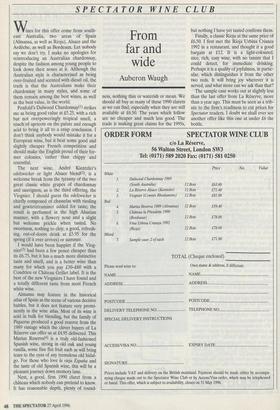SPECTATOR WINE CLUB
From far and wide
Auberon Waugh
Wines for this offer come from south- east Australia, two areas of Spain (Almansa, as well as Rioja), Alsace and the Ardeche, as well as Bordeaux. Let nobody say we don't try. I make no apologies for reintroducing an Australian chardonnay, despite the fashion among young people to look down their noses at it. Although the Australian style is characterised as being over-fruited and scented with diesel oil, the truth is that the Australians make their chardonnay in many styles, and some of them remain among the best wines, as well as the best value, in the world.
Penfold's Dalwood Chardonnay(1) strikes me as being good value at £5.25, with a rich but not overpoweringly tropical smell, a touch of apricots on the palate and enough acid to bring it all to a crisp conclusion. I don't think anybody would mistake it for a European wine, but it beat some good and slightly cheaper French competition and should make the English proud of their for- mer colonies, rather than chippy and resentful.
The next wine, Andre Kientzler's edelzwicker or light Alsace blend(2), is a welcome break from the tyranny of the two great classic white grapes of chardonnay and sauvignon, as is the third offering, the Viognier. I should guess the edelzwicker is chiefly composed of chasselas with riesling and gewiirtztraminer added for taste; the result is perfumed in the high Alsatian manner, with a flowery nose and a slight but welcome prickle when tasted. No sweetness, nothing to cloy; a good, refresh- ing, out-of-doors drink at £5.95 for the spring (if it ever arrives) or summer.
I would have been happier if the Viog- nier(3) had been a few pence cheaper than its £6.75, but it has a much more distinctive taste and smell, and is a better wine than many for which you pay £30—£60 with a Condrieu or Château Grillet label. It is the best of the new Viogniers I have found and a totally different taste from most French white wine.
Almansa may feature in the historical atlas of Spain as the scene of various decisive battles, but it does not feature very promi- nently in the wine atlas. Most of its wine is sold in bulk for blending, but the family of Piqueras produced a good reserve from the 1989 vintage which the clever buyers of La Reserve can offer us at £4.95 delivered. This Marius Reserva(4) is a truly old-fashioned Spanish wine, strong in old oak and young vanilla, some fine flat fruit such as will bring tears to the eyes of any tremulous old hidal- go. For those who love la vieja Espana and the taste of old Spanish wine, this will be a pleasant journey down memory lane.
Next, a good, firm 1990 claret from a château which nobody can pretend to know. It has reasonable depth, plenty of round- ness, nothing thin or waterish or mean. We should all buy as many of these 1990 clarets as we can find, especially when they are still available at £6.50. The years which follow are no cheaper and much less good. The trade is making great claims for the 1995s, but nothing I have yet tasted confirms them.
Finally, a classic Rioja at the same price of £6.50. I first met the Rioja Urbina Crianza 1992 in a restaurant, and thought it a good bargain at £12. It is a light-coloured, nice, rich, easy wine, with no tannin that I could detect, for immediate drinking. Perhaps it is a quality of joyfulness, in partic- ular, which distinguishes it from the other two reds. It will bring joy wherever it is served, and what more can we ask than that?
The sample case works out at slightly less than the last offer from La Reserve, more than a year ago. This must be seen as a trib- ute to the firm's readiness to cut prices for Spectator readers. I doubt we shall ever see another offer like this one at under £6 the bottle.


























































 Previous page
Previous page